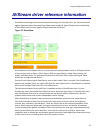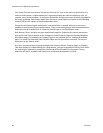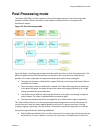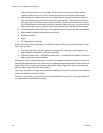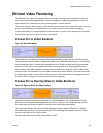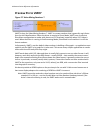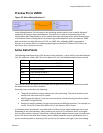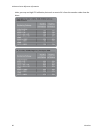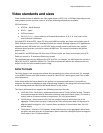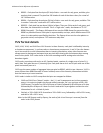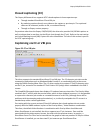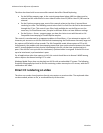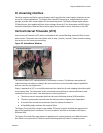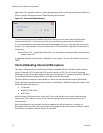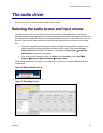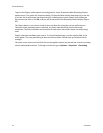Osprey 240e/450e User Guide
ViewCast 67
Video standards and sizes
Video standard refers to whether the video signal format is NTSC, PAL, or SECAM. Depending on the
exact product version you have, some or all of the following standards are available:
525-line formats:
NTSC-M – North America
NTSC-J – Japan
625-line formats:
PAL-B, D, G, H, I – many countries in Europe and elsewhere. B, D, G, H, and I refer to five
nearly identical subformats.
Full-sized NTSC-M and NTSC-J have 525 lines total, 480 lines visible, per frame and a display rate of
59.94 fields per second, or 29.97 interlaced frames per second. Although capture-to-PC applications
normally use only 480 video lines, the full NTSC frame actually contains 485 video lines, and the
AVStream driver provides a control to capture all 485 lines. The control is located on the RefSize
property tab.
Full-sized PAL and SECAM have 625 lines total, 576 lines visible, per frame and a display rate of 50
fields per second, or 25 interlaced frames per second.
The standard frame sizes are different for NTSC and PAL. For example, the half-frame size in pixels is
360 x 240 for NTSC, and 360 x 288 for PAL. The driver automatically adjusts the reference size and
default size for the video standard you are using.
Color formats
The Color format is the arrangement of data bits representing the colors of each pixel. For example,
in the RGB555 format, each pixel of data is stored as 5 bits of red, 5 bits of green, and 5 bits of blue
color information.
Video delivered by the Osprey board to the system is in uncompressed format. It is possible to
compress the video at a subsequent stage of processing. However, this dialog field refers specifically
to the uncompressed raw video that the board delivers to the system.
The Osprey AVStream driver supports the following capture pin formats.
YUY2 and UYVY – Each pixel is represented with a total of 2 bytes (16 bits) of data. The data
is encoded as separate data for luminance (intensity) and chrominance (color). This mode is
mainly used as an input to software compressors. See YUV format details.
YUV12 planar – Also known as I420. This is a complex format in which there are in the
aggregate 12 bits of data per pixel. Each pixel has 8 bits of luminance data. Each group of 4
adjacent pixels arranged in a 2 x 2 square shares two bytes of chrominance data. See YUV
format details.
YVU9 planar – Similar to YUV12 planar, except that there are in the aggregate 9 bits of data
per pixel, and each byte pair of chrominance data is shared by 16 adjacent pixels arranged in
a 4x4 square. See YUV format details.



